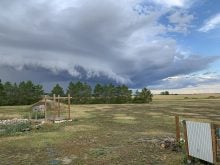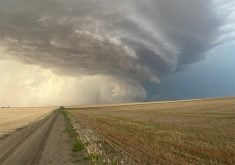I have received a number of emails and have overheard plenty of conversations about wind chill over the last week.
Some of the emails are asking what it is, but most are asking for clarification on whether a -52 C wind chill really means it is -52 C outside.
When we talk about apparent temperature or what it feels like, we are taking into account the water vapour that is in the air, wind speed and the actual air temperature. In the winter, we call this measurement wind chill.
Read Also

Huge Black Sea flax crop to provide stiff competition
Russia and Kazakhstan harvested huge flax crops and will be providing stiff competition in China and the EU.
The explorer Paul Siple first introduced the idea of a wind-chill factor in 1939. It indicates the enhanced rate at which the body will lose heat to the air.
Our bodies help to keep us warm in the winter by trapping a thin layer of air near the surface of our skin. When it is windy, this thin layer is taken away and additional heat from our bodies is released to try and recreate this layer.
This process repeats itself over and over, the higher the wind speed and the faster the warm air is pulled away from our bodies. As well, moisture from our bodies is being evaporated, a process that uses up even more heat from our bodies.
A formula was developed to calculate the rate of heat lost around 1970, and in 2001 the wind-chill formula was revised into what we see and hear about today.
The one thing that still can’t be built into the formula for calculating wind chill is a person’s physical activity, the sun’s intensity and the protective clothing being worn. All these things can decrease the cooling effect of those cold winter winds, and this is where the problem seems to arise.
What I mostly have an issue with is in how the media uses and reports wind chill.
The biggest problem is that they often don’t really understand how wind chill works and tend to apply it to inanimate objects such as a vehicle. It just doesn’t work that way.
Objects can only get as cold as the air temperature. If the wind chill indicates that it feels like it is -52 C but the air temperature is -30 C, then the coldest an object can get is -30 C. This includes people.
What the -52 C means is that you will be losing heat from exposed areas at a rate equivalent to an air temperature that is -52 C, but once you hit -30 C, the object cannot get any colder.
So, you or your car might cool off quicker, but it won’t drop below what the actual air temperature is.
Now, on to our review of last year’s weather across the Prairies.
The above graph shows the mean monthly temperature for each month (line graph) along with the total amount of precipitation for each month (bar graph).
The data is similar across all three locations, which indicates a very similar weather pattern across all three provinces last year.
When looking at the temperatures, two things stand out. The first is that Calgary is much warmer than both Regina and Winnipeg in the winter, but I think most of us already knew that. The second interesting item is that the peak monthly temperature occurred in June rather than July. I think we can all remember back to just how hot June was.
When it comes to total monthly precipitation, the two months that stand out are July and October, when Winnipeg received significantly more precipitation than both Regina and Calgary.
Daniel Bezte is a teacher by profession with a BA in geography, specializing in climatology, from the University of Winnipeg. He operates a computerized weather station near Birds Hill Park, Man. Contact him at dmgbezte@gmail.com.


















